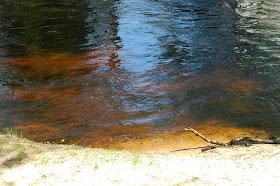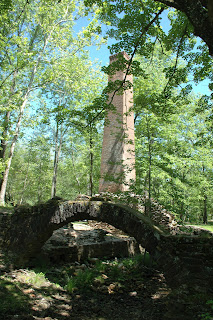Often, when we hit the road, birding's the top priority, with the hopes of finding something obscure or historic along the way. This time of year, the trips start at the crack of dawn so we can be in the appropriate spot by the time the birds wake up for the morning. The primary equipment is binoculars, and many times the only camera on board is the one in my cell phone.
Other times, I make targeted journeys to places I've heard of and want to investigate, camera and notebook in hand. If I find some interesting habitat along the way, I'll make note and maybe stop for a few minutes to check it out for a future return trip with Ivan. I keep a spare set of cheap bins and a Sibley guide in the car in case something compelling shows up, but they often go unused.
Last week I made the latter type of jaunt to the small hamlet of Helmetta, formerly a company town for a snuff mill. After taking a few photos of the shuttered factory, my camera quit on me, so I thought, "that's snuff," and decided to check out what's behind the big building. The story of the factory is for a future
post; for now I'll say it's been closed for about 20 years and some of the surrounding property appears to be in a stage of remediation.
From Main Street, I crossed the railroad tracks in front of the factory and headed down the road between two of the buildings that make up the plant complex. Helmetta Pond is to the left, fronted on the street by a small playground and parking area. New benches, relatively fresh concrete and cinder walkways and a wooden plank observation deck led me to believe that this body of water is being brought back to health after possibly having served as a dumping area for the plant's liquid waste. The opposite side of the pond is fronted by woods and looks a lot less disturbed by the hand of humans.
I noticed a solitary birder with bins raised to eyes, so I figured it was worth taking out the spare optics, rudimentary as they are. I didn't hear anything distinctive, just the usual goose honks and red-winged blackbird calls. Swallows skimmed along the pond's surface, looking for insects, and I figured that might be as exotic as my finds would be on this trip. Still, though, you never know. Somehow I sensed the other birder knew what he was doing, and he was hanging around, so I decided to invest a few more minutes in looking.
Walking along the cinder path, I kept an eye out for movement and an ear out for something, anything but the birds I'd already ID'd. Perhaps there was something on the far end of the pond, maybe a heron or an interesting duck?
Things didn't look very promising, but then I saw something large flying the length of the pond, from left to right, about 20 feet above the water's surface. It was too dark to be a red-tailed hawk or an osprey, and its white head and tail meant it wasn't a turkey vulture. Could it be?
I watched as it flapped its wings to soar higher and farther away from me. "Come on, come back," I said under my breath, quickly inventorying as many of the bird's attributes as I could while trying not to influence my own judgement by hoping it was what I thought it could be. (Just about any beginning birder can wish a house sparrow into becoming a rarity.) Despite my whispered entreaties, the bird continued to the farthest end of the pond and did a few circles before coming to rest in one of the leafed-out trees.
What other bird is that big and has a white head and a white tail? This fella obviously wasn't going to give me another look, so I did the next best thing and called Ivan for an opinion. "The only other possibility is black-backed gull," he told me, but no way could a gull be as big as the bird in question.
Yup, I'd just identified a mature bald eagle on my own, for the very first time. I've already seen a handful with Ivan, and belatedly identified an immature one I scared off on my March solo trip to Brigantine, but this one was special. I hadn't been expecting to bird that day, and nothing about the place had indicated I'd find anything but the usual suspects there. And, well, there's something eminently satisfying about making such a great discovery in a place that's not exactly a well-known birding hotspot.
The other birder was still around, so I asked if he'd seen the eagle. He hadn't but said it was likely what I saw; there's a nesting pair not far away in Old Bridge. He also told me he'd seen a much wider array of birds in the park than I had, making it a nice little spot to check out in the future. Score one for the novice!









